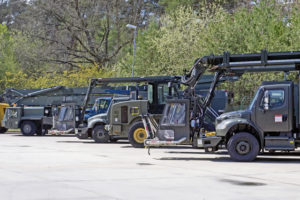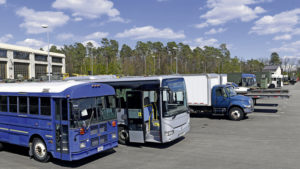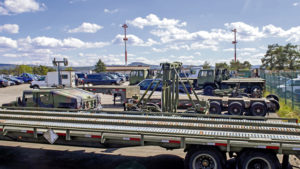
Unexpected budget cuts of approximately $1.3 million affecting the 86th Airlift Wing’s vehicle sustainment operations have forced the wing to park hundreds of its vehicles, impacting many operations across the installation.
Vehicle sustainment funds are used for vehicle maintenance and repairs to the 86th Vehicle Readiness Squadron’s fleet of 1,600 vehicles that support the base. The fleet includes vehicles used for a variety of mission-related purposes such as maintenance requests, construction operations, emergency response capabilities, transportation of goods, and additional tasks essential to daily operations seen around Ramstein.
Parking hundreds of vehicles until sustainment funds are available will likely cause delays to services across the installation that aren’t directly related to higher-priority operations such as emergency response and base defense. A ripple effect is expected to occur that may delay household goods transportation, pending unit work orders, and housing maintenance requests regarding plumbing, pest control, and painting, among other things.
In response to this funding loss, the 86th VRS has prioritized all vehicles into three categories in order to sustain vehicles based on their mission support role.
“The priority one category includes minimum essential level (MEL) vehicles, such as emergency response and base defense vehicles; the priority two category includes non-MEL special purpose vehicles, such as forklifts, tractors, aircraft loaders, and cranes; and the priority three category will include non-MEL general purpose vehicles, such as sedans, pick-up trucks, and vans,” said Capt. Elizabeth Gentine, 86th VRS vehicle management flight commander.

Funding cuts were evenly applied across the Air Force in order to balance the must-pay $1.2 billion vehicle contract bill. This even distribution of cuts across bases located in the U.S. and overseas is exceptionally challenging for Ramstein due to the installation’s size, unique support requirements, and location challenges.
“There aren’t any Air Force bases that compare to Ramstein when it comes to providing support for an organic fleet of vehicles of this size,” Gentine said.
Sustaining vehicles that were made in the U.S. adds other challenges, including longer delivery times for replacement parts, difficulties with acquiring replacement and rental vehicles when needed, and having limited options to contract support from the local economy.
“When our funding was cut, the mission capable rate for our entire fleet was 70 percent, which is considered healthy. As of today we are already down to 57 percent,” she explained.
The 86th VRS recalled approximately 300 vehicles across multiple units on base in order to fulfill the parking and prioritization plan. Units have turned in more than 200 vehicles to date, and around 100 more vehicles are expected to fulfill recall requirements. This initiative is considered necessary for the wing to ensure future mission readiness by avoiding collective maintenance risks during a time when vehicles cannot be fixed if they require repairs.
Most units will feel the impact of the budget cuts and sustainment plan. To put this into perspective, if a section of the 86th Maintenance Group loses one vehicle at this time, it will reduce overall capabilities by approximately 33 percent of the affected section. If the vehicle is considered a specialized vehicle, the loss will likely degrade the unit’s capabilities to meet mission essential requirements. Similar time and wear-and-tear challenges are being reported from units across the base.

When it comes to generating airlift, the 86th Logistics Readiness Squadron is considered a key component alongside their maintenance counterparts.
“The loss of vehicles will severely impact our ability to support the 86th AW airdrop operations and will create a severe disruption to the shipment of household goods, as well as disrupt our ability to conduct fueling operations and maintaining quality standards for Fuels, Liquid Oxygen and Nitrogen products,” said Capt. Noel Castillo, 86th LRS director of operations.
All of these actions require consistent use of vehicles sustained by the 86th VRS, therefore as time goes on, the risk of mission degradation increases.
The 86th Security Forces Squadron is also preparing for major impacts, such as possible delays in overall response time due to pre-existing vehicle sustainment challenges.
“Our average time in repair status was over 130 days before the vehicle park plan; it will likely be significantly longer now,” said First Lt. Hurl Millikin, 86th SFS logistics and readiness officer in charge. “We use vehicles for every aspect of our mission to ensure base defense and capabilities, which makes this sustainment plan essential to mitigating risk associated with our ongoing vehicle challenges.”
Some of the impacts that the 86th Civil Engineer Squadron are preparing for include reduced emergency response support capabilities, the possibility of halting numerous construction projects, adding significant additional delays to responding to work order requests, and the cost associated with these delays over time.
“Suspending all or most construction projects would cost on average about $120,000 per day, or about $2.9 million per month in delay costs,” according to Russell Hume, 86th CES deputy director.
“Depending on how long this goes on, we might be forced to cancel construction projects, which would then double expenses because we would have to pay our current contractor for lost time and materials purchased to date, and then re-compete for funds to restart these projects in the future, with no guarantees,” Hume said.
Representatives from the 786th Civil Engineer Squadron expressed how the sustainment plan will cause severe delays to non-emergency, “quality of life” work orders such as office remodels and other building enhancements. Additionally, contracts related to COVID-19 disinfection will experience delays and/or cancellations due to contract oversight being unavailable from the limited vehicle support.
The recent sustainment plan is only one part of the solution to this enterprise-wide challenge, and it has caused many units to understand the linchpin role that vehicles play in successfully completing the mission.
Base leaders are monitoring the situation and compiling data about the impacts on unit operations to keep higher headquarters informed.


